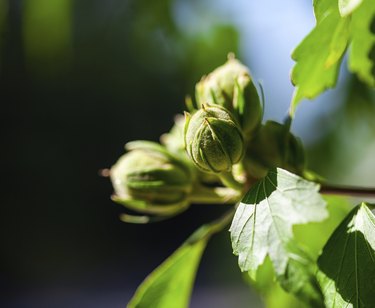
The delicious, sweet nuts and small size of the hazelnut, or filbert tree, make it a welcome addition to a backyard orchard. The native hazelnut (Corylus americana) thrives in U.S. Department of Agriculture plant hardiness zones 4 through 9, while its close relative, the European filbert (Corylus avellana) prefers USDA zones 5 through 8. Both shrubby trees have numerous suckers and require regular pruning to maintain as a small tree.
Safety First
Video of the Day
Before plunging into pruning, put on long pants and sleeves, gloves, and safety goggles to protect your skin, hands and eyes from errant twigs and branches. Also prepare a disinfecting solution for your pruners, using equal parts rubbing alcohol and water. Dipping your pruners into a disinfectant between pruning cuts helps prevent the spread of disease.
Video of the Day
Tree, Shrub or Hedge
Because of its short, shrubby, spreading habit, a hazelnut is easily pruned into a small tree, shrub or hedge. To form a tree, begin in late winter, when the tree is dormant. Prune the hazelnut to one sturdy stem, removing the lower branches and root suckers. Remove branches by cutting them just outside of the thickened branch collar, which is next to the trunk. Also remove any crossing branches and dead branches. To maintain the tree form, monitor the tree and remove suckers as soon as they appear.
Ornamental Hazelnut Trees
In addition to the nut-producing varieties of hazelnut trees, the ornamental varieties also need regular pruning to shape the tree and remove crowded, crossing or dead wood. The twisted branches of corkscrew hazelnut (Corylus avellana "Contorta"), also known as Harry Lauder's walking stick, requires regular trimming to expose the interesting branches and remove suckers. The Turkish filbert (Corylus colurna) grows up to 40 feet tall, making it suitable as a landscape or street tree. While it is also prone to suckering, which requires regular pruning, this filbert naturally grows into a tree. The corkscrew hazelnut thrives in USDA zones 4 through 8 while the Turkish filbert prefers the cooler temperatures of USDA zones 4 through 7.
A Dangerous Infection
Hazelnut trees are susceptible to a serious fungal infection called Eastern Filbert Blight (Anisogramma anomala). If cankers appear on the tree's limbs or trunk, wait until the weather is dry to prune the infected branches 2 to 3 feet below the canker. All infected areas should be removed, so if a tree is fully involved, it should be cut down and destroyed. If the infection is caught early, begin a program of pruning out infected branches and applying fungicides, such as a ready-to-use Bordeaux mix. Thoroughly spray the tree with the solution beginning at bud break, then reapply every two weeks for a total of four applications.
- Missouri Botanical Garden: Corylus Americana
- University of Illinlos Extension: European Filbert
- Missouri Botanical Garden: Corylus Avellana "Contorta"
- Missouri Botanical Garden: Corylus Colurna
- Oregon State University Extension Service: Pruning to Remove Eastern Filbert Blight
- Oregon State University Extension Service: Strategies for Using Fungicides for Management of Eastern Filbert Blight
- UC IPM Online: Eastern Filbert Blight -- Anisogramma Anomala